Introduction
Geoconservation of open-air geosites is a key point of discussion in UNESCO Global Geoparks. According to the European Association for Conservation of Geological Heritage (ProGEO 2017), “Geoconservation is defined as a set of actions aimed at informing the management of geological sites, in or ex-situ, comprising inventory and assessment, conservation, statutory protection, interpretation and monitoring of sites”.
Open-air paleontological sites are highly susceptible to weathering and anthropogenic activity even when they are correctly managed and protected. Geoconservation measures are increasingly being applied to significant paleontological outcrops, such as the Fumanya sauropod footprints in Central Catalonia, the titanosaur egg nests in Orígens Geopark or the sauropod, stegosaurid and ornithopod footprints in Maestrazgo Geopark. Some geoconservation examples are a joint project between Manchester University, Institut Català de Paleontologia (ICP) and Barcelona Autonomous University (UAB) to produce a 3D digital representation using LiDar (Terrestrial Light Detection and Range) technology (Vila et al. 2006; Bates et al. 2008) of a spectacular sauropod tracks outcrop in Fumanya, Central Catalonia or the restoration project led by ICP to reconstruct the “Cretaceous Viewpoint” (Mirador del Cretaci) Geosite in Orígens Geopark, with one of the most important titanosaur egg nests in the world including 25 to 30 clutches of megaloolithid eggs, which was seriously vandalized in 2015, aiming to preserve the educational and geotourism interest of the site.
The main tools to protect natural and cultural heritage are educational and legal concepts included in heritage laws. However, some of these are unclear and can be interpreted in different ways. The first mention of fossil protection in Spanish legislation was made in Article 40.1 of the Spanish Historical Heritage law 16/1985, which states that geological and paleontological elements related to the history of man and his origins are part of the (Historical) Heritage.
Following this initial legislation, the Spanish government transferred the management of cultural heritage to the Autonomous Communities. The first Catalan Heritage Law (Act 9/1993) included sites with paleontological remains as cultural heritage. This act strictly prohibits the collection of fossils anywhere in the Catalan territory and states that prospecting, excavation, and conservation of paleontological deposits are managed by the Department of Culture of the Catalan Government. The law establishes two levels of heritage protection: Sites of National Cultural Interest (BCIN by its acronym in Catalan) and Sites of Local Cultural Interest (BCIL). BCINs constitute the highest category of protection awarded by a regional government and are also recognized as Elements of Cultural Interest by the Spanish central administration. This figure establishes a set of protection measures, criteria for their conservation and rehabilitation and guarantees public access to sites. BCILs include heritage sites managed by local authorities.
At a Central Government level, Law 42/2007 and its subsequent amendment in Law 33/2015 on Natural Heritage and Biodiversity, describe the geological heritage as a set of natural geological resources of scientific, cultural and/or educational value including geological formations and structures, landforms, minerals, rocks, meteorites, fossils, soils and other geological manifestations that allow us to know, study and interpret: (1) the origin and evolution of the Earth, (2) the processes that have modeled it, (3) the climates and landscapes of the past and present and (4) the origin and evolution of life.
Having in mind the described legislation, we propose here to examine the geotourism and education potential of 15 paleontological dinosaur sites in the Spanish pre-Pyrenees (Fig. 1) and assess their susceptibility to weathering and anthropogenic activity. We anticipate that this work will aid in decision-making for the implementation of appropriate geoconservation measures.
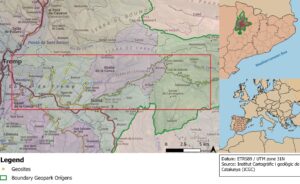
Figure 1. Location of the study area and the sites recorded within the Orígens Geopark. The Geopark area is outlined in green. The region outlined in red indicates the area where most of the dinosaur remains are recorded and illustrates the area covered by Figure 3.
Geographical and Geological Context
The 15 sites are located within the boundaries of Orígens UNESCO Global Geopark in the southern sector of the Catalan Pyrenees. The Geopark comprises 19 municipalities, covering an area of 2,040 km2. The main sites of interest are mostly focused on the municipalities of Isona i Conca de Dellá, Tremp and Coll de Nargó (Fig. 1).
Tectonic movements of compression associated with the formation of the Pyrenees between the Upper Cretaceous and the Miocene contributed to the formation of four main synclineal structures throughout the Southern Pyrenees (Puigdefàbregas & Souquet 1986) where most of the vertebrate paleontological sites are recorded: the Vallcebre and Coll de Nargó synclines to the east and the Tremp and Àger synclines to the west (Dalla Vecchia et al. 2014). The sites presented here are in the Tremp and Coll de Nargó structural basins (Fig. 2).
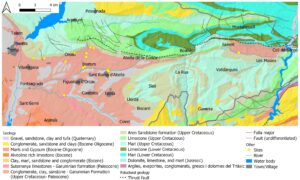
Figure 2. Geological setting of the study area, with yellow markers to indicate the sites presented in this work. The geological background has been modified from Institut Cartogràfic i Geològic de Catalunya geological map at 1: 50,000 scale. The Suterranya Limestones–Garumnian Formation illustrates the approximate position of the K/Pg limit.
The landscape of the area during the Late Cretaceous (Campanian) was an enclosed sedimentary basin opening and deepening westwards. The sedimentary record shows a transition from continental to marine facies during this period (Díaz-Molina 1987; Ardèvol et al. 2000; Rosell et al. 2001). However, a marine regression during the early Maastrichtian in the eastern and central Pyrenees caused a shift to continental conditions associated with diversification of vertebrates in the area (Sellés et al. 2013).
Dinosaur fossils are recorded in the upper Campanian to upper Maastrichtian (72–66 Ma). At that time, Europe was an archipelago, and the Iberian Peninsula and the south of France were part of the Armorican Island. The climate was tropical, with vegetation dominated by palm trees, ferns, and conifers (Fig. 3; Marmi et al. 2016a). Vertebrate remains have been recorded both in the Aren Sandstone Formation and the Tremp Group (Mey et al. 1968). The Arén Sandstone Formation consists of quartz-rich sandstones with medium to large-scale cross-stratification interpreted as coastal paleoenvironments with barrier island systems and deltaic deposits (Riera et al. 2009). The age of this formation ranges from late Campanian to late Maastrichtian (Ardèvol et al. 2000). The Tremp Group, generally overlying the Arén Sandstone Formation, ranges from late Campanian to late Paleocene (Mey et al. 1968; Willems 1985). The Garumnian Formation was subdivided by Rosell et al. (2001) into the La Posa Formation (Cuevas 1992) consisting of grey pelites with some coal beds, charophyte limestone and sandstone, the Conques Formation (Cuevas 1992) formed by red pelites (fluvial fàcies) with some sandstones and rare paleosol beds and, the Cenozoic Suterranya limestones and Upper Red Garumnian facies (Fig. 2).
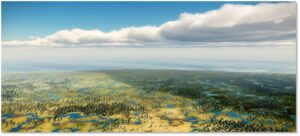
Figure 3. Idealized scene of the landscape of the Tremp Basin during the Late Cretaceous consisting of a plain along a coastal area in a tropical climate. © Oscar Sanisidro/ICP.
Geosite Significance and Geotourism Potential
A geosite is a site of geological importance, containing information about the conformation and dynamics of the Earth (Bruno et al. 2014). These sites are selected within a contextual framework to assess their international significance. A number of aspects are considered: (1) representativeness and/or interest of the geological record and time-range represented; (2) presence of exceptional landforms; (3) paleontological content; (4) existence of relevant tectonic and structural elements; (5) toccurrence of unusual or unique minerals, rocks and/or sedimentary structures; and (6) possibility of identifying paleogeographies and/or paleoenvironments that reveal the geological evolution of the region (Carcavilla et al. 2019; García-Cortés et al. 2000; Avendaño Gil et al. 2020). Moreover, these sites can be classified based on their facies: paleoecosystem, ichnological value, taphonomic patterns, catastrophic events and geoarcheological importance (Bruno et al. 2014).
We present an inventory of 15 sites (Table 1) located in the Orígens Geopark where significant paleontological remains have been discovered from 1917 to the present day. The data from these sites has provided key information to reconstruct the paleoclimate and paleoenvironment of the Late Cretaceous (Riera et al. 2009; Vila et al. 2011, 2016; Sellés et al. 2013).
Table 1. Name, brief description, and legal protection of the fifteen sites presented in this work. BCIN stands for Cultural Feature of National Interest (Bé Cultural d’interès nacional).

Methods
The inventory was carried out in three stages. First, the sites were selected based on taphonomic interest, age and chronology, degree of conservation of the fossils and their taxonomic value. Second, a modified version of a questionnaire developed by García-Cortés & Carcavilla (2009) tailored to the needs of the Spanish Geological Survey (IGME, by its acronym in Spanish), was synthetized for its use in characterizating the paleontological sites of the study area. The questionnaire was modified by: (1) focusing its reference on paleontological aspects; (2) adapting its scale to typical paleontological outcrops; and (3) adjusting the scores to the aims of the project and to characteristics of outcrops with vertebrate fossil remains. The questionnaire (See an example in Supplementary data) included the following fields: location, physiography, socio-economic conditions, geological context, scientific, educational and tourism interest, protection measures, vulnerability, use and monitoring. Finally, a field campaign was carried out to outline, characterize and classify the selected sites.
The field classification questionnaire (See an example in Supplementary data) includes several sections that were scored from 0 to 4, where 4 corresponds to very high and 0 to very low interest. The final score was obtained by adding the values gathered in each section, and sites with high interest scores were considered relevant as educational and tourism sites. The vulnerability section was treated separately, with high vulnerability scores indicating high susceptibility to weathering or anthropogenic activity.
Results
The study area comprises some of the richest sites for dinosaur fossils in the Pyrenees. These have provided many fossilized dinosaur bones, eggs, and ichnites. Several genera of dinosaurs have been described from the Tremp Group and Arén Formation as well as a rich variety of other reptiles. These sites are representative of the fauna and flora of the Upper Cretaceous Tremp Basin. Several have been thoroughly excavated and have provided a great amount of data (e.g., Marmi et al. 2016b; Vila et al. 2016; Fondevilla et al. 2019; Conti et al. 2020), based on the analysis of large quantities of fossils. As an example, the Basturs-1, Basturs-2 and Mirador del Cretaci sites are considered among the most significant titanosaur eggs nests with very well-preserved samples of megaloolithid eggs.
The scoring system (see Supplementary data) enabled us to obtain a numerical result for each of the sites depending on the geoturism and educational interest, as well as their vulnerability to natural (e.g., weathering) and anthropogenic activity. Sites with high interest scores (Table 2) are well preserved and easily accessible (La Posa, Orcau-2) or recently restored and well-equipped sites, such as Mirador del Cretaci. Low scores indicate sites with insufficient fossil content (Suterranya and Basturs poble), poor conservation or difficult access (Masia de Ramón, Costa Roia and Sant Romà d'Abella I). Sites with high vulnerability have a high risk of over-collecting, such as Magret and Les Torres, from lack of legal protection or fragility of the outcrop by bedrock type and position. One example of the latter is the position of Llau de la Costa outcrop, at the bottom of a gorge affected by seasonal storm events, which makes the site highly vulnerable. Low vulnerability scores indicate outcrops on relatively hard bedrock (La Posa) or sites with low remaining fossil content (Suterranya, Basturs Poble, Molí de Baró and Costa Roia).
Table 2. Scoring results drawn from field site characterization. The two sites marked in gray are not yet declared as BCIN and therefore are in a situation of high legal vulnerability.
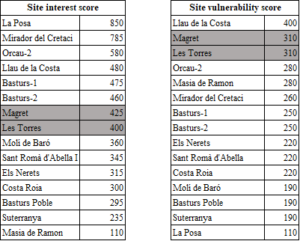
Sites with low fossil recovery or without exposed fossils are not considered for tourism or education. Therefore, even though they have provided a large quantity of fossil remains in the past, the Sant Romà d’Abella I, Suterranya, Molí del Baró, Els Nerets, Masia de Ramón, Basturs Poble and La Costa Roia sites do not currently show any in situ exposed fossils and therefore cannot be considered candidates as open-air museums, but the remaining sites are all candidates. However, the Magret and Les Torres sites (Fig. 4) have not yet been declared as BCINs and, although they have significant potential for the development of outreach activities, would require legal protection before contemplating any action.
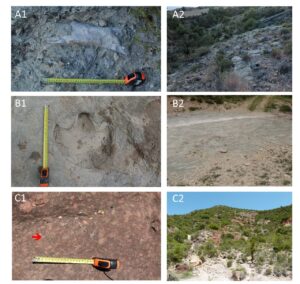
Figure 4. Geology and fossils in the Orígens Geopark. A1) Fragment of dinosaur bone in les Torres site and an associated image; A2) of the site context. B1) Detail of tridactyl dinosaur footprints, from a hadrosaur dinosaur, in Llau de la Costa site and an associated image; B2) of the context. C1) Titanosaur eggs of the Megaloolithidae family recorded in Basturs-1 site and an associated image; C2) of the site context.
Geosites Conservation: Actions, Solutions, and Limitations
The concept of an open-air museum originated in the late 19th century in Scandinavia (Rentzhog 2007) and has spread worldwide since. The Mirador del Cretaci, La Posa, and Orcau-2 sites are already equipped and open to the public. However, these sites still have room for further development in both geotourism and geoconservation. Mirador del Cretaci would require strengthened security measures by increasing the frequency of visits by rural agents and the installation of security cameras for a 24 h surveillance system. La Posa is quite a resilient geosite, but regular cleaning should be carried out and an information panel describing the significant sedimentary structures recorded in the outcrop and their paleoenvironmental conditions would widen its geotourism and educational interest.
On the other hand, a joint ICP and Orígens Geopark geoconservation project at Orcau-2, involving installation of an additional geoconservation panel and a fence along the outcrop face, producing an audio guide with a strong geoconservation message and improving safe access to the site, will improve the geotourism interest and protection of the site. Other sites discussed here also have the potential for development as open-air museums. However, these have high vulnerability scores and several geoconservation aspects have to be addressed to improve their protection. High vulnerability is often related to the risk of weathering and erosion, as well as the risk to over-collection and fragility of the remaining fossils. Conservation and preservation measures are recommended for each of the geosites based on the vulnerability score.
Sites without exposed fossils do not have educational or tourism interest and therefore do not require any further protection. On the other hand, the Basturs-1, Basturs-2 and Llau de la Costa geosites have potential to be opened to the public, but with some restrictions. Even though some of these sites have high interest scores, they also show high fragility scores (Table 2) as these are in remote areas and have a high risk of spoliation. In such situations, opening these sites to the public would require extreme protection measures or limiting visits to guided tours led by professionals linked to the Conca Dellà Museum, and including a strong geoconservation message. Further, not only should the sites be adapted to guarantee visitor safety, but access roads should be upgraded so they can be used by any type of vehicle all year round. Once these issues are addressed, the Basturs-1, Les Torres (Fig. 4A), Llau de la Costa (Fig. 4B) and Magret geosites could allow attractive geotourism and educational activities consisting of guided routes where visitors could see three aspects of the dinosaurian fossil record: footprints, bones, and egg clutches.
The last site, the Magret geosite, is formed from a few blocks with dinosaur bones situated precariously along the edge of a forest road with a high risk of rolling downslope. We recommend that these blocks should be moved to a flat area and the bones consolidated to avoid further degradation. Also, a transparent structure could be installed to protect them from possible acts of vandalism or spoliation.
Conclusions
Geoconservation and promotion must be evaluated individually for each site as each has its own particularities. Fragile outcrops with a high risk of spoliation can be shown to the public but only when the correct protective measures have been considered. Episodes of vandalism at Mirador del Cretaci were mainly a consequence of ignorance by the perpetrators about the value of these sites. Further education on this subject, especially at a local level, may help to improve the monitoring and preservation of sites.
The use of a rating system streamlines the process of diagnosis and protection of paleontological sites. This methodology helps to identify and to characterize both the very fragile deposits and those that show significant tourism and educational potential. Seven of the evaluated sites, despite their high scientific relevance, do not have in situ fossil remains and therefore should be omitted as candidates for potential open-air museums. The remaining locations have enough potential to be developed as educational and/or tourism sites. Nevertheless, protection measures should be applied to preserve them from both natural degradation and anthropogenic activity.
The Orígens UNESCO Global Geopark comprises significant sites that should be shown to the public. However, their geoconservation is of prime importance so future generations can also enjoy and learn from their invaluable paleontological heritage. In general, the sites in the Orígens UNESCO Global Geopark are of great scientific importance. However, most outcrops are small and sometimes difficult to access, so it is recommended that tours are led by professional guides with a good paleontological background. The use of professional guides should help to raise awareness among visitors about the importance of protecting the paleontological heritage and can contribute to monitoring site geoconservation needs.
Acknowledgments
This research is a contribution to Orígens UNESCO Global Geopark (Catalunya, Spain). Scientific research and excavations have been supported by the Departament de Cultura de la Generalitat de Catalunya, CERCA program (Departament d’Empresa i Coneixement, Generalitat de Catalunya) and Ministerio de Ciencia e Innovacion.
